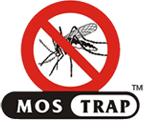About Mosquito
home>about mostrapOnly the females bite!
Only the female mosquito bites. Male mosquitoes feed primarily on flower nectar, whereas female mosquitoes require a blood meal to provide protein for their eggs. Typically, they consume more than their own body weight in blood. Different species of mosquito prefer to feed at different times of the day or night.
Midges and sandflies, as well as mosquitoes, locate you by sight, smell and by sensing the heat radiating from your body. As well as being able to see you with their large compound eyes, they can smell the carbon dioxide you exhale and the lactic acid in your perspiration. What's more, they detect movement by infra-red radiation. This ability to sense you in three different ways means that mosquitoes can find you from up to 36 metres (120') away.
Methods of mosquito and midge control
The key to mosquito control is adulticiding the pests. This simply means killing the adult insects so that they don't have the opportunity to breed. Your local council helps to do this by using larvicides. Larvicides are simply chemicals that kill an insect's eggs or larvae. This might be effective in the short term, but it fails to eradicate an insect population in the long term. The Mostrap Mosquito Trap breaks the breeding cycle of these insects by eradicating the adult females before they have a chance to lay their eggs. The Mostrap Mosquito Trap not only controls the local insect population but also prevents new populations from establishing. Typically, most mosquitoes and other biting insects do not migrate. 90% live and feed within 100 metres (300') from where they breed (swamp mosquitoes are an exception) and the other 10% are blown in from neighbouring areas by the wind. By attracting and eradicating these renegade mosquitoes, the Mostrap Mosquito Trap prevents new populations establishing. Mosquitoes produce up to 3000 offspring during their six-week lifecycle, so for every mosquito killed it prevents 3000 offspring being born.
Biting insect fact: Carbon dioxide
In recent years, scientists have established that blood-sucking insects are attracted to their blood meal by the smell of carbon dioxide. That is, the exhaled breath of humans and animals. But while they are attracted by short bursts of carbon dioxide, continuously released carbon dioxide has the opposite effect. Carbon dioxide released mainly from the breath but also from the skin serve as a long-range airborne attractant and can be detected by biting insects at distances of up to 36 metres (120').
Biting insect fact: Lactic acid
Lactic acid is produced as a result of vertebrate muscle metabolism, and is released through human and animal perspiration. Mosquitoes have chemoreceptors on their antennae that are stimulated by the scent of acid. And, although humans are unable to smell it, blood-sucking insects find it irresistible.
Biting insect fact: Octenol
Octenol, described as 'cow's breath in a can', has been found to be a remarkable lure for mosquitoes. The discovery was made by accident by scientists in South Africa studying the Tsetse fly. It was later confirmed when a mosquito outbreak in Florida USA was killing cattle. It was found that the lungs of the cattle were filled with mosquitoes, they were inhaling more mosquitoes than air!
Biting insect fact: Heat & Moisture
At close range, skin temperature and moisture serve as attractants. It has been known for many years that females of many species of mosquitoes will be attracted to a source of heat via infra-red radiation, in particular warm moisture
Biting insect fact: Spectrum & Ultraviolet light
Adult insects possess both compound eyes and ocelli. Compound eyes are used for navigation and sensing movement, patterns, contrast and colour, while ocelli are believed to sense light levels. Research has found that the retina of the compound eye in differing species of flying insects is sensitive to differing wavelengths of light.
Biting insect fact: Color
Mosquitoes are attracted to dark colours.




